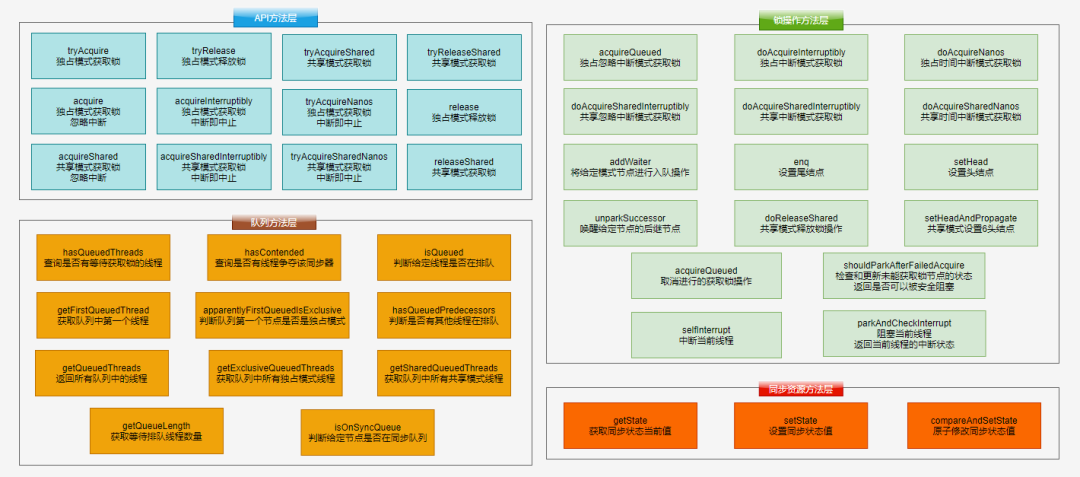- 概述
- 数据结构
- 主要方法解析
tryAcquire/tryAcquireShared(int arg)tryRelease/tryReleaseShared(int arg)acquire/acquireShared(int arg)acquireInterruptibly/acquireSharedInterruptibly(int arg)tryAcquireNanos/tryAcquireSharedNanos(int arg, long nanosTimeout)release/releaseShared(int arg)addWaiter(Node mode)enq(final Node node)shouldParkAfterFailedAcquire(Node pred, Node node)parkAndCheckInterrupt()cancelAcquire(Node node)hasQueuedPredecessors()
概述
AbstractQueuedSynchronizer可以称为抽象队列同步器。
AQS有独占模式和共享模式两种:
- 独占模式
公平锁:
非公平锁:
/**
- 同步等待队列的尾结点 */ private transient volatile Node tail;
/**
同步资源状态 */ private volatile int state;
<a name="xJDcl"></a>#### 内部类```javastatic final class Node {/*** 标记节点为共享模式*/static final Node SHARED = new Node();/*** 标记节点为独占模式*/static final Node EXCLUSIVE = null;static final int CANCELLED = 1;static final int SIGNAL = -1;static final int CONDITION = -2;static final int PROPAGATE = -3;/*** CANCELLED: 值为1,表示当前的线程被取消* SIGNAL: 值为-1,表示当前节点的后继节点包含的线程需要运行,也就是unpark;* CONDITION: 值为-2,表示当前节点在等待condition,也就是在condition队列中;* PROPAGATE: 值为-3,表示当前场景下后续的acquireShared能够得以执行;* 0: 表示当前节点在sync队列中,等待着获取锁。* 表示当前节点的状态值*/volatile int waitStatus;/*** 前置节点*/volatile Node prev;/*** 后继节点*/volatile Node next;/*** 节点同步状态的线程*/volatile Thread thread;/*** 存储condition队列中的后继节点*/Node nextWaiter;/*** 是否为共享模式*/final boolean isShared() {return nextWaiter == SHARED;}/*** 获取前驱结点*/final Node predecessor() throws NullPointerException {Node p = prev;if (p == null)throw new NullPointerException();elsereturn p;}Node() { // Used to establish initial head or SHARED marker}Node(Thread thread, Node mode) { // Used by addWaiterthis.nextWaiter = mode;this.thread = thread;}Node(Thread thread, int waitStatus) { // Used by Conditionthis.waitStatus = waitStatus;this.thread = thread;}}
主要方法解析
tryAcquire/tryAcquireShared(int arg)独占/共享模式获取锁;由子类实现,仅仅获取锁,获取锁失败时不进行阻塞排队。
tryRelease/tryReleaseShared(int arg)独占/共享模式释放锁;由子类实现,仅仅释放锁,释放锁成功不对后继节点进行唤醒操作。
acquire/acquireShared(int arg)独占/共享模式获取锁,如果线程被中断唤醒,会返回线程中断状态,不会抛异常中止执行操作(忽略中断)。
acquireInterruptibly/acquireSharedInterruptibly(int arg)独占/共享模式获取锁,线程如果被中断唤醒,则抛出InterruptedException异常(中断即中止)。
tryAcquireNanos/tryAcquireSharedNanos(int arg, long nanosTimeout)独占/共享时间中断模式获取锁,线程如果被中断唤醒,则抛出InterruptedException异常(中断即中止);如果超出等待时间则返回加锁失败。
release/releaseShared(int arg)addWaiter(Node mode)将给定模式节点进行入队操作。
private Node addWaiter(Node mode) {// 根据指定模式,新建一个当前节点的对象Node node = new Node(Thread.currentThread(), mode);// Try the fast path of enq; backup to full enq on failureNode pred = tail;if (pred != null) {// 将当前节点的前置节点指向之前的尾结点node.prev = pred;// 将当前等待的节点设置为尾结点(原子操作)if (compareAndSetTail(pred, node)) {// 之前尾结点的后继节点设置为当前等待的节点pred.next = node;return node;}}enq(node);return node;}
enq(final Node node)将节点设置为尾结点。注意这里会进行自旋操作,确保节点设置成功。因为等待的线程需要被唤醒操作;如果操作失败,当前节点没有与其他节点没有引用指向关系,一直就不会被唤醒(除非程序代码中断线程)。 ```java private Node enq(final Node node) { for (;;) {
Node t = tail;// 判断尾结点是否为空,尾结点初始值是为空if (t == null) { // Must initialize// 尾结点为空,需要初始化if (compareAndSetHead(new Node()))tail = head;} else {// 设置当前节点设置为尾结点node.prev = t;if (compareAndSetTail(t, node)) {t.next = node;return t;}}
} }
<a name="xOBCm"></a>#### `acquireQueued(final Node node, int arg)`已经在队列当中的节点,准备阻塞获取锁。在阻塞前会判断前置节点是否为头结点,如果为头结点;这时会尝试获取下锁(因为这时头结点有可能会释放锁)。```javafinal boolean acquireQueued(final Node node, int arg) {boolean failed = true;try {boolean interrupted = false;for (;;) {// 当前节点的前置节点final Node p = node.predecessor();// 入队前会先判断下该节点的前置节点是否是头节点(此时头结点有可能会释放锁);然后尝试去抢锁// 在非公平锁场景下有可能会抢锁失败,这时候会继续往下执行 阻塞线程if (p == head && tryAcquire(arg)) {//如果抢到锁,将头节点后移(也就是将该节点设置为头结点)setHead(node);p.next = null; // help GCfailed = false;return interrupted;}// 如果前置节点不是头结点,或者当前节点抢锁失败;通过shouldParkAfterFailedAcquire判断是否应该阻塞// 当前置节点的状态为SIGNAL=-1,才可以安全被parkAndCheckInterrupt阻塞线程if (shouldParkAfterFailedAcquire(p, node) &&parkAndCheckInterrupt())// 该线程已被中断interrupted = true;}} finally {if (failed)cancelAcquire(node);}}
shouldParkAfterFailedAcquire(Node pred, Node node)
检查和更新未能获取锁节点的状态,返回是否可以被安全阻塞。
private static boolean shouldParkAfterFailedAcquire(Node pred, Node node) {int ws = pred.waitStatus; // 获取前置节点的状态if (ws == Node.SIGNAL)/** 前置节点的状态waitStatus为SIGNAL=-1,当前线程可以安全的阻塞*/return true;if (ws > 0) {/** 如果前置节点的状态waitStatus>0,即waitStatus为CANCELLED=1(无效节点),需要从同步状态队列中取消等待(移除队列)*/do {node.prev = pred = pred.prev;} while (pred.waitStatus > 0);pred.next = node;} else {/** 将前置状态的waitStatus修改为SIGNAL=-1,然后当前节点才可以被安全的阻塞*/compareAndSetWaitStatus(pred, ws, Node.SIGNAL);}return false;}
parkAndCheckInterrupt()
阻塞当前节点,返回当前线程的中断状态。
private final boolean parkAndCheckInterrupt() {LockSupport.park(this); //阻塞return Thread.interrupted();}
cancelAcquire(Node node)
取消进行的获取锁操作,在非忽略中断模式下,线程被中断唤醒抛异常时会调用该方法。
// 将当前节点的状态设置为CANCELLED,无效的节点,同时移除队列private void cancelAcquire(Node node) {if (node == null)return;node.thread = null;Node pred = node.prev;while (pred.waitStatus > 0)node.prev = pred = pred.prev;Node predNext = pred.next;node.waitStatus = Node.CANCELLED;if (node == tail && compareAndSetTail(node, pred)) {compareAndSetNext(pred, predNext, null);} else {int ws;if (pred != head &&((ws = pred.waitStatus) == Node.SIGNAL ||(ws <= 0 && compareAndSetWaitStatus(pred, ws, Node.SIGNAL))) &&pred.thread != null) {Node next = node.next;if (next != null && next.waitStatus <= 0)compareAndSetNext(pred, predNext, next);} else {unparkSuccessor(node);}node.next = node; // help GC}}
hasQueuedPredecessors()
判断当前线程是否应该排队。
1.第一种结果——返回true:(1.1和1.2同时存在,1.2.1和1.2.2有一个存在)
1.1 h != t为true,说明头结点和尾结点不相等,表示队列中至少有两个不同节点存在,至少有一点不为null。
1.2 ((s = h.next) == null || s.thread != Thread.currentThread())为true
1.2.1 (s = h.next) == null为true,表示头结点之后没有后续节点。
1.2.2 (s = h.next) == null为false,s.thread != Thread.currentThread()为true
表示头结点之后有后续节点,但是头节点的下一个节点不是当前线程
2.第二种结果——返回false,无需排队。(2.1和2.2有一个存在)
2.1 h != t为false,即h == t;表示h和t同时为null或者h和t是同一个节点,无后续节点。
2.2 h != t为true,((s = h.next) == null || s.thread != Thread.currentThread())为false
表示队列中至少有两个不同节点存在,同时持有锁的线程为当前线程。
public final boolean hasQueuedPredecessors() {Node t = tail; // Read fields in reverse initialization orderNode h = head;Node s;return h != t &&((s = h.next) == null || s.thread != Thread.currentThread());}


